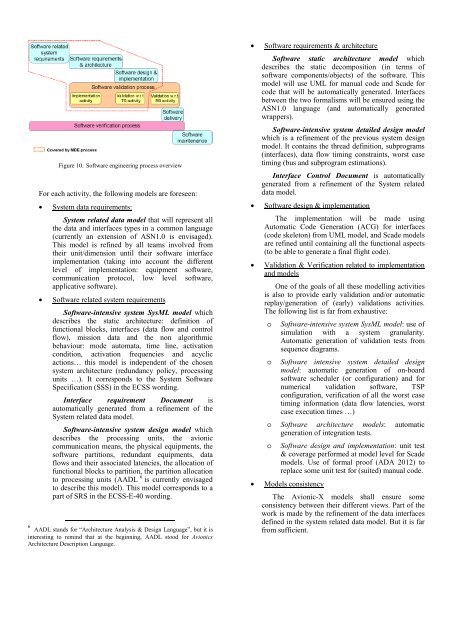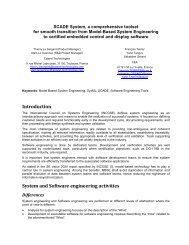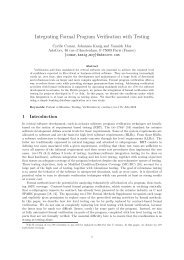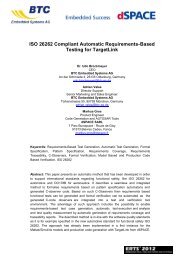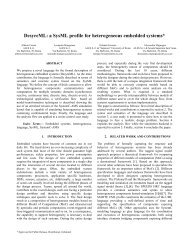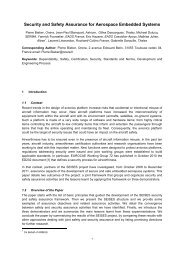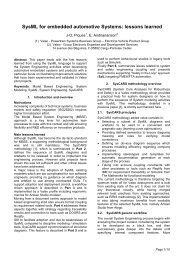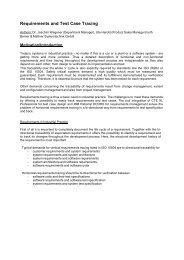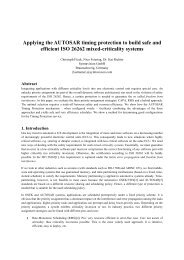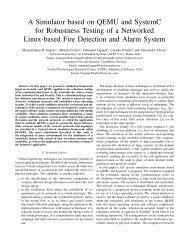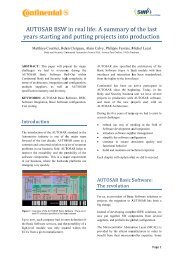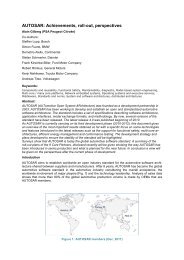Avionic-X: A demonstrator for the Next Generation Launcher Avionics
Avionic-X: A demonstrator for the Next Generation Launcher Avionics
Avionic-X: A demonstrator for the Next Generation Launcher Avionics
Create successful ePaper yourself
Turn your PDF publications into a flip-book with our unique Google optimized e-Paper software.
Figure 10. Software engineering process overviewFor each activity, <strong>the</strong> following models are <strong>for</strong>eseen:• System data requirements:System related data model that will represent all<strong>the</strong> data and interfaces types in a common language(currently an extension of ASN1.0 is envisaged).This model is refined by all teams involved from<strong>the</strong>ir unit/dimension until <strong>the</strong>ir software interfaceimplementation (taking into account <strong>the</strong> differentlevel of implementation: equipment software,communication protocol, low level software,applicative software).• Software related system requirementsSoftware-intensive system SysML model whichdescribes <strong>the</strong> static architecture: definition offunctional blocks, interfaces (data flow and controlflow), mission data and <strong>the</strong> non algorithmicbehaviour: mode automata, time line, activationcondition, activation frequencies and acyclicactions… this model is independent of <strong>the</strong> chosensystem architecture (redundancy policy, processingunits …). It corresponds to <strong>the</strong> System SoftwareSpecification (SSS) in <strong>the</strong> ECSS wording.Interface requirement Document isautomatically generated from a refinement of <strong>the</strong>System related data model.Software-intensive system design model whichdescribes <strong>the</strong> processing units, <strong>the</strong> avioniccommunication means, <strong>the</strong> physical equipments, <strong>the</strong>software partitions, redundant equipments, dataflows and <strong>the</strong>ir associated latencies, <strong>the</strong> allocation offunctional blocks to partition, <strong>the</strong> partition allocationto processing units (AADL 6 is currently envisagedto describe this model). This model corresponds to apart of SRS in <strong>the</strong> ECSS-E-40 wording.6 AADL stands <strong>for</strong> “Architecture Analysis & Design Language”, but it isinteresting to remind that at <strong>the</strong> beginning, AADL stood <strong>for</strong> <strong>Avionic</strong>sArchitecture Description Language.• Software requirements & architectureSoftware static architecture model whichdescribes <strong>the</strong> static decomposition (in terms ofsoftware components/objects) of <strong>the</strong> software. Thismodel will use UML <strong>for</strong> manual code and Scade <strong>for</strong>code that will be automatically generated. Interfacesbetween <strong>the</strong> two <strong>for</strong>malisms will be ensured using <strong>the</strong>ASN1.0 language (and automatically generatedwrappers).Software-intensive system detailed design modelwhich is a refinement of <strong>the</strong> previous system designmodel. It contains <strong>the</strong> thread definition, subprograms(interfaces), data flow timing constraints, worst casetiming (bus and subprogram estimations).Interface Control Document is automaticallygenerated from a refinement of <strong>the</strong> System relateddata model.• Software design & implementationThe implementation will be made usingAutomatic Code <strong>Generation</strong> (ACG) <strong>for</strong> interfaces(code skeleton) from UML model, and Scade modelsare refined until containing all <strong>the</strong> functional aspects(to be able to generate a final flight code).• Validation & Verification related to implementationand modelsOne of <strong>the</strong> goals of all <strong>the</strong>se modelling activitiesis also to provide early validation and/or automaticreplay/generation of (early) validations activities.The following list is far from exhaustive:ooSoftware-intensive system SysML model: use ofsimulation with a system granularity.Automatic generation of validation tests fromsequence diagrams.Software intensive system detailed designmodel: automatic generation of on-boardsoftware scheduler (or configuration) and <strong>for</strong>numerical validation software, TSPconfiguration, verification of all <strong>the</strong> worst casetiming in<strong>for</strong>mation (data flow latencies, worstcase execution times …)o Software architecture models: automaticgeneration of integration tests.oSoftware design and implementation: unit test& coverage per<strong>for</strong>med at model level <strong>for</strong> Scademodels. Use of <strong>for</strong>mal proof (ADA 2012) toreplace some unit test <strong>for</strong> (suited) manual code.• Models consistencyThe <strong>Avionic</strong>-X models shall ensure someconsistency between <strong>the</strong>ir different views. Part of <strong>the</strong>work is made by <strong>the</strong> refinement of <strong>the</strong> data interfacesdefined in <strong>the</strong> system related data model. But it is farfrom sufficient.


